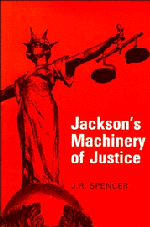Book contents
- Frontmatter
- Contents
- Acknowledgements
- List of figures
- List of tables
- Preface
- Preface to the first edition of ‘The Machinery of Justice in England’
- Abbreviations
- I Historical introduction
- II Civil jurisdiction
- III Tribunals
- IV Criminal jurisdiction
- V The personnel of the law
- 27 Solicitors
- 28 Barristers
- 29 Legal education
- 30 Should the profession continue to be divided into barristers and solicitors?
- 31 Judges
- 32 Juries
- 33 Lay justices and stipendiary magistrates
- 34 The administration of the courts
- VI The European dimension
- VII The cost of the law
- VIII Law Reform
- Appendix A The Report of the Civil Justice Review
- Table of Cases cited
- Table of Statutes cited
- Table of Stationery Office publications cited
- Index
34 - The administration of the courts
Published online by Cambridge University Press: 10 January 2011
- Frontmatter
- Contents
- Acknowledgements
- List of figures
- List of tables
- Preface
- Preface to the first edition of ‘The Machinery of Justice in England’
- Abbreviations
- I Historical introduction
- II Civil jurisdiction
- III Tribunals
- IV Criminal jurisdiction
- V The personnel of the law
- 27 Solicitors
- 28 Barristers
- 29 Legal education
- 30 Should the profession continue to be divided into barristers and solicitors?
- 31 Judges
- 32 Juries
- 33 Lay justices and stipendiary magistrates
- 34 The administration of the courts
- VI The European dimension
- VII The cost of the law
- VIII Law Reform
- Appendix A The Report of the Civil Justice Review
- Table of Cases cited
- Table of Statutes cited
- Table of Stationery Office publications cited
- Index
Summary
Perhaps the most astonishing chapter in the history of our law courts is that dealing with the official staff. Medieval law had a poorly developed notion of contract and a highly developed law of property. Offices, such as clerkships in the courts, came to be regarded as property; the official had a freehold for life in the office, just as he might have such a freehold in land. As the work of the courts increased the staff was not increased accordingly, for that would have interfered with property: the process was for the office holder to continue to receive the fees, but for him to employ men to do the work. In the early nineteenth century the chief clerk of the King's Bench received on an average £6,280 a year, and paid his deputy £200 a year. The patronage to these highly paid or sinecure offices was partly in the government and partly in the judges: ‘The fact that many highly placed people both in the fashionable and the judicial world had an interest in these offices, made the system extraordinarily difficult to eliminate.’
Royal Commissions investigated, and a series of statutes ending with the Courts of Justice Salaries and Funds Act 1869 converted court officials into salaried officials with pension rights assimilated to the civil service.
- Type
- Chapter
- Information
- Jackson's Machinery of Justice , pp. 421 - 426Publisher: Cambridge University PressPrint publication year: 1989

